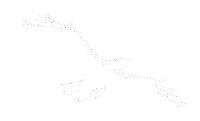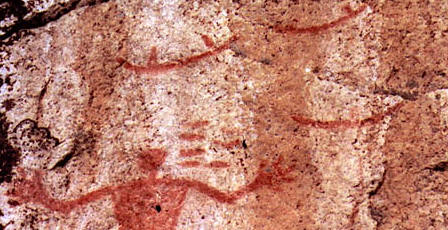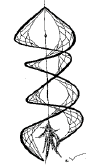Tradition of the
sea-shell--Tradition of the otter--Separation of the Ojibways,
Potta-wat-umees and Ottaways at the straits of Michilimacinac--Origin of
their tribal names--Causes of their emigration from the Atlantic seaboard--Ojibways
settle at Sault Ste. Marie--They separate into two divisions-Movements of
the northern division--Traditional anecdote of the war between the Marten
and the Omush-kas families--Movements of the southern division--Allegory of
the cranes--Copper-plate register of the Crane family--Era of their first
occupation of Point Shaug-a-waum-ik-ong--Tradition of the extermination of
the Mundua tribe.
The history of the Ojibway tribe, till within the past
five centuries, lies buried in darkness and almost utter oblivion. In the
preceding chapter we have feebly attempted to lift the veil which covers
their past, by offering well-founded facts which can be excusably used in
the formation of conjectures and probabilities. All is, however, still
nothing but surmise and uncertainty, and what of this nature has been
presented, has not been given, nor can it be considered as authentic
history. We will now descend to times and events which are reached by their
oral historic traditions, and which may be offered as certain, though not
minute history. Through close inquiry and study of their vague figurative
traditions, we have discovered that the Ojibways have attained to their
present geographical position, nearly in the center of the North American
continent, from the shores of the Atlantic Ocean, about the Gulf of the St.
Lawrence trivet. The manner in which I first received a certain intimation
of this fact, may illustrate it more forcibly to the reader, and is
presented as follows:--
I was once standing near the entrance of an Ojibway Me-da-we-gaun,
more commonly known as the "Grand Medicine Lodge," while the inmates were
busy in the performance of the varied ceremonies of this, their chief
medical and religious rite. The lodge measured in length about one hundred
feet, and fifteen in width, was but partially covered along the sides with
green boughs of the balsam tree, and the outside spectator could view
without hindrance the different ceremonies enacting within. On a pole raised
horizontally above its whole length were hung pieces of cloth, calico,
handkerchiefs, blankets, etc.--the offerings or sacrifice of the novice who
was about to be initiated into the mysteries of the Me-da-we society. The
lodge was full of men and women who sat in a row along both of its sides.
None but those who were members of the society and who had regularly been
initiated were allowed to enter. They were dressed and painted in their best
and most fancy clothing and colors, and each held in his hand the Mc-da-wi-aun
or medicine sack, which consisted of bird skins, stuffed otter, beaver and
snake skins.
The novice in the process of initiation, sat in the center
on a clean mat facing the Me-da-wautig, a cedar post planted in the center
of the lodge, daubed with vermilion and ornamented with tufts of birds'
down. The four old and grave-looking We-kauns, or initiating priests, stood
around him with their medicine sacks, drums, and rattles.
As I partially understood, and could therefore appreciate,
the meaning and objects of their strange ceremonies, and could partially
understand their peculiar religious idiom, I stood, watched, and listened
with a far deeper interest than could be felt in the mind of a mere casual
observer, who is both unacquainted with the objects of the rites or language
of these simple children of nature, and who, in his greater wisdom, deems it
but the unmeaning mummery and superstitious rites of an ignorant race,
buried in heathenish darkness.
One of the four We-kauns, after addressing a few remarks
to the novice in a low voice, took from his medicine sack, the Me-da-me-gis,
a small white seashell, which is the chief emblem of the Me-da-we rite.
Holding this on the palm of his hand, he ran slowly around the inside of the
lodge, displaying it to the inmates, and followed by his fellow We-kauns
swinging their rattles, and exclaiming in a deep guttural tone, "whe, whe,
whe." Circling the lodge in this impressive manner, on coming again to the
novice, they stopped running, uttering a deep, sonorous, "Whay-ho-ho-ho."
They then quietly walked off, and taking their stand at the western end of
the lodge, the leader still displaying the shell on the palm of his hand,
delivered a loud and spirited harangue.
The language and phrases used were so obscure to a common
listener, that it would be impossible to give a literal translation of the
whole speech. The following passage, however, forcibly struck my attention:
"While our forefathers were living on the great salt water
toward the rising sun, the great Megis (sea-shell) showed itself above the
surface of the great water, and the rays of the sun for a long period were
reflected from its glossy back. It gave warmth and light to the An-ish-in-aub-ag
(red race). All at once it sank into the deep, and for a time our ancestors
were not blessed with its light. It rose to the surface and appeared again
on the great river which drains the waters of the Great Lakes, and again for
a long time it gave life to our forefathers, and reflected back the rays of
the sun. Again it disappeared from sight and it rose not, till it appeared
to the eyes of the An-ish-in-aub-ag on the shores of the first great lake.
Again it sank from sight, and death daily visited the wigwams of our
forefathers, till it showed its back, and reflected the rays of the sun once
more at Bow-e-ting (Sault Ste. Marie). Here it remained for a long time, but
once more, and for the last time, it disappeared, and the An-ish-in-aub-ag
was left in darkness and misery, till it floated and once more showed its
bright back at Mo-ning-wun-a-kaun-ing (La Pointe Island), where it has ever
since reflected back the rays of the sun, and blessed our ancestors with
life, light, and wisdom. Its rays reach the remotest village of the wide
spread Ojibways." As the old man delivered this talk, he continued to
display the shell, which he represented as the emblem of the great, megis of
which he was speaking.
A few days after, anxious to learn the true meaning of
this allegory, I proceeded one evening to the lodge of the old priest, and
presenting him with some tobacco and cloth for a pair of leggings (which is
an invariable custom when any genuine information is wanted of them,
connected with their religious beliefs), I requested him to explain to me
the meaning of his Me-da-we harangue.
After filling his pipe and smoking of the tobacco I had
presented, he proceeded to give me the desired information as follows:--
"My grandson," said he, "the megis I spoke of, means the
Me-da-we religion. Our forefathers, many string of lives ago, lived on the
shores of the Great Salt Water in the east. Here it was, that while
congregated in a great town, and while they were suffering the ravages of
sickness and death, the Great Spirit, at the intercession of Man-ab-o-sho,
the great common uncle of the An-ish-in-aub-ag, granted them this rite
wherewith life is restored and prolonged. Our forefathers moved from the
shores of the great water, and proceeded westward. The Me-da-we lodge was
pulled down and it was not again erected, till our forefathers again took
a stand on the shores of the great river near where Mo-ne-aung (Montreal)
now stands.
"In the course of time this town was again deserted, and
our forefathers still proceeding westward, lit not their fires till they
reached the shores of Lake Huron, where again the rites of the Me-de-we
were practiced.
"Again these rites were forgotten, and the Me-de-we
lodge was not built till the Ojibways found themselves congregated at
Bow-e-ting (outlet of Lake Superior), where it remained for many winters.
Still the Ojibways moved westward, and for the last time the Me-de-we
lodge was erected on the Island of La Pointe, and here, long before the
pale face appeared among them. it was practiced in its purest and most
original form. Many of our fathers lived the full term of life granted to
mankind by the Great Spirit, and the forms of many old people were mingled
with each rising generation. This, my grandson, is the meaning of the
words you did not understand; they have been repeated to us by our fathers
for many generations."
Thus was it that I first received particular corroborating
testimony to the somewhat mooted point of the direction from which the
Ojibways have reached their present geographical position. It is only from
such religious and genuine traditions that the fact is to be ascertained.
The common class of the tribe who are spread in numerous villages north and
west of Lake Superior, when asked where they originally came from, make
answer that they originated from Mo-ning-wuna-kaun-ing (La Pointe), and the
phrase is often used in their speeches to the whites, that "Mo-ning-wuna-kaun-ing"
is the spot on which the Ojibway tribe first grew, and like a tree it has
spread its branches in every direction, in the bands that now occupy the
vast extent of the Ojibway earth; and also that "it is the root from which
all the far scattered villages of the tribe have sprung."
A superficial inquirer would be easily misled by these
assertions, and it is only through such vague and figurative traditions as
the one we have related, that any degree of certainty can be arrived at,
respecting their position and movements prior to the time when the tribe
first lit their central fire, and built their Me-da-we lodge on the Island
of La Pointe.
There is another tradition told by the old men of the
Ojibway village of Fond du Lac--Lake Superior, which tells of their former
residence on the shores of the great salt water. It is, however, so similar
in character to the one I have related, that its introduction here would
occupy unnecessary space. The only difference between the two traditions, is
that the otter, which is emblematical of one of the four Medicine spirits,
who are believed to preside over the Medawe rites, is used in one, in the
same figurative manner as the sea-shell is used in the other; first
appearing to the ancient An-ish-in-aub-ag from the depths of the great salt
water, again on the river St. Lawrence, then on Lake Huron at Sault Ste.
Marie, again at La Pointe, but lastly at Fond du Lac, or end of Lake
Superior, where it is said to have forced the sand bank at the mouth of the
St. Louis River. The place is still pointed out by the Indians where they
believe the great otter broke through.
It is comparatively but a few generations back, that this
tribe have been known by their present distinctive name of Ojibway. It is
certainly not more than three centuries, and in all probability much less.
It is only within this term of time, that they have been disconnected as a
distinct or separate tribe from the Ottaways and Potta-wat-um-ies. The names
by which they were known when incorporated in one body, is at the present
day uncertain.
The final separation of these three tribes took place at
the Straits of Michilimacinac from natural causes, and the partition has
been more and more distinctly defined, and perpetuated through locality, and
by each of the three divided sections assuming or receiving distinctive
appellations:--
The Ottaways remaining about the spot of their final separation, and being
thereby the most easterly section, were first discovered by the white race,
who bartered with them their merchandise for furs. They for many years acted
as a medium between the white traders and their more remote western
brethren, providing them in turn at advanced prices, with their much-desired
commodities. They thus obtained the name of Ot-tah-way, "trader," which they
have retained as their tribal name to the present day. The Potta-wat-um-ees
moved up Lake Michigan, and by taking with them, or for a time perpetuating
the national fire, which according to tradition was sacredly kept alive in
their more primitive days, they have obtained the name of "those who make or
keep the fire," which is the literal meaning of their tribal cognomen.
The Ojibways, pressing northward and westward, were soon
known as an important and distinctive body or tribe, and meeting with fierce
and inveterate enemies, the name of Ojibway, "to roast till puckered up,"
they soon obtained through practicing the old custom of torturing prisoners
of war by fire, as has already been mentioned more fully in a previous
chapter. The original cause of their emigration from the shores of the
Atlantic westward to the area of Lake Superior is buried in uncertainty. If
pressed or driven back by more powerful tribes, which are a most probable
conjecture, they are not willing to acknowledge it. (See History of Ojibways
based upon documents, in this volume.)
From the earliest period that their historical traditions
treat of, they tell of having carried on an exterminating war with the
Iroquois, or Six Nations of New York, whom they term Naud-o-waig, or Adders.
The name indicates the deadly nature of these, their old and powerful
antagonists, whose concentrated strength and numbers, and first acquaintance
with the use of the white man's murderous fire arms, caused them to leave
their ancient village sites and seek westward for new homes.
Sufficient has been seen and written since their discovery
by the white race, of the antagonistical position of these two different
families, or group of tribes, to prove the certainty of the above surmise.
The name of Naud-o-wa-se-wug, which is sometimes applied to the Dakotas by
the Ojibways, is derived from the name by which they have ever known the
Iroquois.--Naud-o-waig; it implies "our enemies," but literally, means "like
unto the adders." Various definitions have been given to this name by
different writers; the above is now presented as the only true one.
It is a well-authenticated fact traditionally, that at the
Fails of Sault Ste. Marie, the outlet of Lake Superior, the Ojibways, after
separating from the Ottaways and Pottawatumees, made a long and protracted
stay. Their village occupied a large extent of ground, and their war parties
numbered many warriors who marched eastward against the Naudoways, and
westward against the Dakotas, with whom at this point they first came into
collision.
continue chapter 4
1
- 2
- 3
- 4
- 5
- 6
- 7
- 8
- 9
- 10
11
- 12
- 13
- 14
- 15
- 16
- 17
- 18
- 19
- 20
21
- 22
- 23
- 24
- 25 - 26 - 27 - 28 - 29 - 30
White Eagle Soaring: Dream Dancer of the 7th Fire








 Get
a course to promote your business online, explode your sales
Get
a course to promote your business online, explode your sales Get
software to promote your business online in less time
Get
software to promote your business online in less time Get
software to streamline your business and run it hands free.
Get
software to streamline your business and run it hands free.